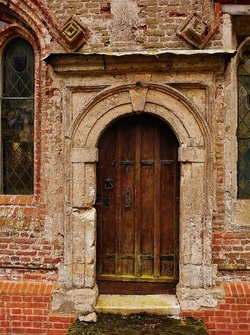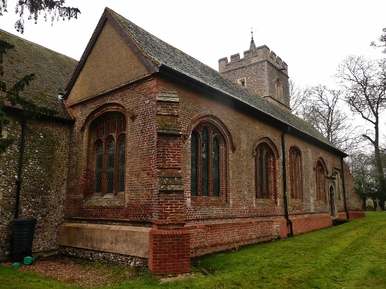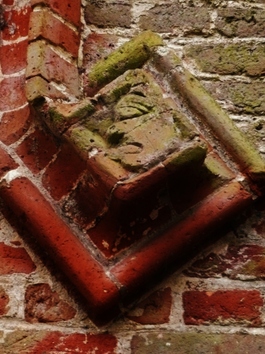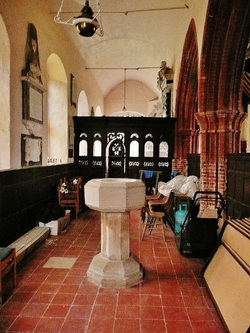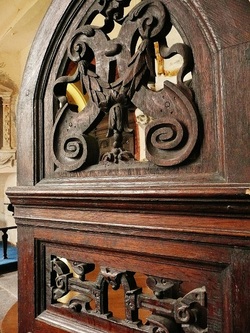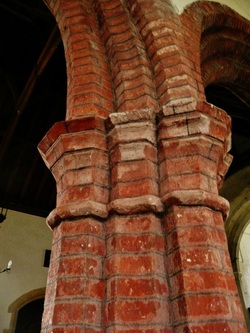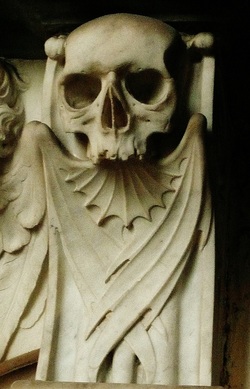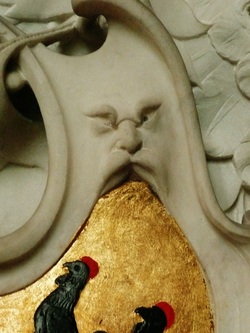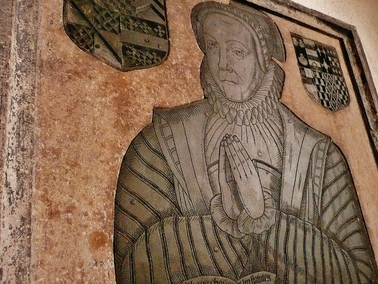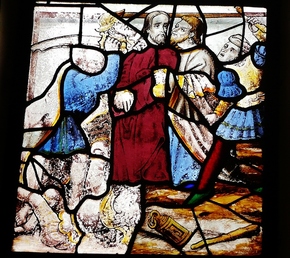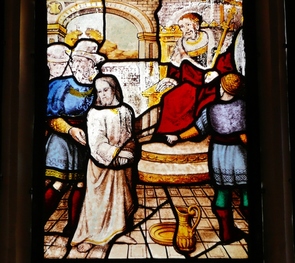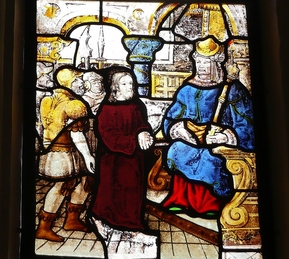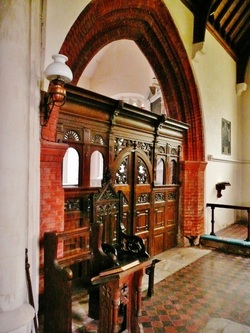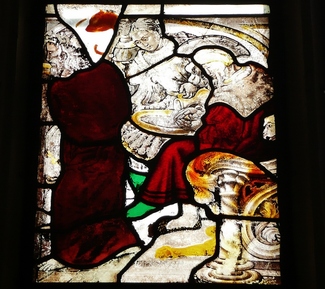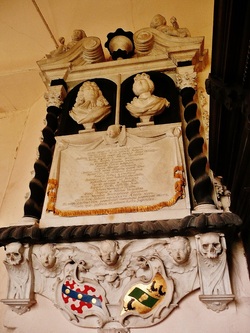St. Giles, Wyddial.
Messy church.
The over arching trees that enclose the roads in dappled green tunnels open up by the long brick walls of a Victorian model farm, the pride and joy of Wyddial Bury, with its Elizabethan wing presenting a jettied facade to the road. The Hall lies behind the churchyard, a long white Georgian affair now neauveau’d to within an inch of its life and presently looking for a new oligarch to swim in its pool. Four million quid and its dubious aesthetic delights are yours. The church lies back basking on its lawn, rather too much restored. The porch is Victorian, as are the south windows, only the slim tower hints at its age. A walk round the back reveals much more of interest, as the north aisle is all Tudor brick with windows to match. A look at the diamond shaped drip stones reveals spitting faces, shorthand for the Passion at that time. The north doorway is classical, part of a C17th refurbishment, of which more inside.
My first interior impression was of the state of the place. I’d been happy to find the church open, as the last few times I’d been past it was locked, but my joy was tempered with sadness at the cavalier way it was being treated. Chairs heaped at the west end, metal trestle tables leaned against screens, evangelical advertising dumped on every surface, electric heaters hanging from the roof, and boxes of rubbish and even two diesel mowers strewn across the north aisle. This is not an irredeemable state of affairs, as the bones of such a building will carry a lot of superficial damage, so there could be hope for the future yet. A little t.l.c. would go a long way.
Messy church.
The over arching trees that enclose the roads in dappled green tunnels open up by the long brick walls of a Victorian model farm, the pride and joy of Wyddial Bury, with its Elizabethan wing presenting a jettied facade to the road. The Hall lies behind the churchyard, a long white Georgian affair now neauveau’d to within an inch of its life and presently looking for a new oligarch to swim in its pool. Four million quid and its dubious aesthetic delights are yours. The church lies back basking on its lawn, rather too much restored. The porch is Victorian, as are the south windows, only the slim tower hints at its age. A walk round the back reveals much more of interest, as the north aisle is all Tudor brick with windows to match. A look at the diamond shaped drip stones reveals spitting faces, shorthand for the Passion at that time. The north doorway is classical, part of a C17th refurbishment, of which more inside.
My first interior impression was of the state of the place. I’d been happy to find the church open, as the last few times I’d been past it was locked, but my joy was tempered with sadness at the cavalier way it was being treated. Chairs heaped at the west end, metal trestle tables leaned against screens, evangelical advertising dumped on every surface, electric heaters hanging from the roof, and boxes of rubbish and even two diesel mowers strewn across the north aisle. This is not an irredeemable state of affairs, as the bones of such a building will carry a lot of superficial damage, so there could be hope for the future yet. A little t.l.c. would go a long way.
This north aisle is precisely dated on a brass to 1532; its rare brick arcade has complex mouldings and was originally plastered; the Victorians liked stripping walls to get at the “honest” stone or brick below. This was responsible for the loss of ancient murals and resulted in darker churches; here the brick is not that pretty, and in places has modern tuck pointing with black mortar, not a good look. Lime plaster would help an awful lot of churches to be less dreary, as rubble or flint are not really suitable interior finishes. In the mid C17th, the aisle was refurbished with splendid new screens and box pews, dividing it off to a great extent from the rest of the church as a private chapel. It was at this time that the classical doorway was added in the north wall, presumably to allow separate access from the Hall, which underneath its Georgian dress dates from around the same time. The screens would look equally at home in a domestic environment, with restrained openwork of scrolls, strapwork and swags. There are double doors between chancel and chapel, single between chapel and aisle, with open arches above the high dado and a dentilled entablature along the top. The screens between aisle and nave are simpler, being chest high, with panelling along the north wall. This is all that remains of the box pews, ripped out since Pevsner visited, a grievous loss.
There is a large beautifully engraved portrait on brass in the chancel of Margaret Plumbe, 1575, showing her at prayer. The face is particularly good, the size unusual. There’s a metropolitan memorial to Sir William Goulston of 1687, with skulls wrapping their wings around themselves as if for warmth and cherubs stretching their pinions above melting shields that morph into masks, grotesque becoming rococo before its time. Above the epitaph are the busts of Sir William and his wife, twisted black columns spiralling up the sides.
The windows of the north aisle are the jam in this doughnut; eight good sized panels of early sixteenth century Flemish glass. These show the Passion in flamboyant Tudor dress, mostly drawn in the yellows produced by silver stain, but also with unusual sky blues, dark reds, and bright Veronese green touches. They are quite large rectangular panels, and would benefit from resetting, as the existing Victorian surrounds do the glass no favours. Even so, the north aisle and chapel with their fittings should be the pride of the village and it’s a shameful thing that they’re left as they are.
You’ll need to check opening first; despite everything it’s worth a visit. Maybe the new owners of the hall would like to find some box pews. . . . The church is on Vicarage Road, the warden nearby is on 01763 271520.
All rights reserved for this entire site. Copyright reserved to stiffleaf for all text and images, which may not be reproduced without my permission.
